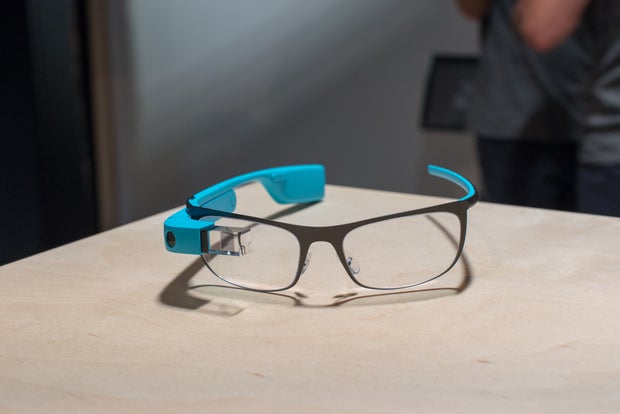Google Glass review – hands on, UK price and best apps

We explain how to buy Google Glass in the UK, its UK price and give our hands-on impressions of Google Glass
Google Glass is the company’s long-in-development wearable. While other companies focus on smartwatches, Google is taking a different approach with its high-tech smart spectacles. Glass is essentially a computer that sits on your face, with a tiny screen displaying apps, maps, messages and pretty much anything else available through the operating system. Google Glass is now available in the UK, having previously only been available in the US. We’ve got all the details you need including how to buy it in the UK, how much it costs and hands-on impressions from our time with Google Glass.
UK price
Google Glass costs a whopping £1,000 in the UK and is only available through Google’s ‘Explorer’ programme. The price is likely to come down when it leaves testing and goes on general sale, but Google is yet to give an indidcation of exactly how much Glass will cost. To get on the Explorer programme you need to be a US or UK resident and be over 18 years of age.
Google Glass hands on review
When we first tried out Google Glass over a year ago the product only came in its original form: a frameless set of glasses with the screen mounted just in front of your eye. These were no good if you wore glasses, as there was no easy way to fit both your regular set and Glass comfortably together. Since then Google has expanded its range to include prescription lenses. They can also be fitted with plain glass, which sounds a little odd, but actually works.
The original model wasn’t too comfortable, with Glass resting on our nose. With a proper frame and lenses the smart glasses feel that comfortable to wear and a lot more natural. Perhaps it’s because we’re used to glasses, but this definitely feels like a step forwards. We also think that they look better, with the rims giving a better sense of design than the plain-looking originals.

There’s bad news for short-sighted people in the UK, though, as while they can choose the Glass frames they want, they can’t currently buy any prescription lenses. We were told by Google that it’s working with opticians to bring this to the UK, but the technology means that the lenses have to be properly measured and fitted in order to work.
Also not available in the UK are the Dianna von Furstenberg designer frames. We got a sneak peek at what they look like and they’re available in the US now, but over here we’re going to have to wait. We have no idea of pricing, but there’s a premium for these frames in the US, so we’d expect them to cost more over here.

Also available from Google are sunglasses. These are the only set of frames where you can unclip the sunglass component, leaving you with the original Google Glass design. There’s a good choice of colours available and we found them pretty comfortable to wear. You can’t buy prescription sunglasses in the UK, so these are really only for people with regular sight and contact lens wearers.

Screen
Wearing Glass for the first time is a slightly strange experience as the screen is always in your peripheral vision. At first it’s a little distracting and the natural thing you want to do is raise your eyes up to look at it. After wearing them for a while your brain learns how to ignore the display and only look up to it when you need to find something out.
This design is no accident and the position of the screen is something that Google’s Sergey Brin hopes will end smartphone addiction. Brin explained during a brief appearance at a TED Conference last year and explained that peering down at your phone all the time is antisocial. “In addition to potentially socially isolating yourself when you are out and about using your phone, I feel it is kind of emasculating,” Brin told the audience.
The Glass display has a resolution of 640×360 pixels, which sounds a little lame when you consider the high-resolution screens you find in smartphones and tablets. However, at the distance you’re looking at it from, this is like watching a high-resolution 25in screen from 2.4m away. Everything looks sharp and neat on the display. Care has to go into designing the apps so that they fit correctly but if this has been done properly Glass is a great experience.
Technical specs
Glass runs on Android 4.4.2 KitKat. The update has improved battery life and added lots of new features, with some little-used options removed. Video calling is no longer available on Glass, with Google claiming less than 10 per cent of people were using it.
On the inside Glass has 2GB of memory, 16GB of Flash storage and a 5 megapixel camera that can record video at 720p. It also has Wi-Fi, Bluetooth, a micro USB port, GPS, accelerometer, compass and gyroscope. The processor has been reported as a Texas Instruments OMAP 4430, although the clock speed isn’t clear.
Interface
Glass is controlled in two ways: by voice commands and the touchpad mounted on the side. You use your voice most of the time, especially for more complicated tasks. If you want to turn on navigation, for example, you can just talk to Glass and get it to enter the address of where you want to go. It’s all powered by Google Maps and Google Voice and worked well even in a very loud room.

Once you’re in an app or just want to navigate through menus you use the touchpad on the side of Glass. You can swipe in all directions and tap to select. It takes a little getting used to, particularly as you can’t see what you’re touching but once you do it becomes second-nature. Our one minor complaint is that this touchpad area, which also houses the CPU and memory, can get quite hot, particularly when Glass is running a complicated app.
Apps
As part of the demonstration we got to try out a variety of apps available for Glass. Known as Glassware these apps have been specially written for Glass in order to properly use the screen, touchpad and voice commands. There are new apps coming all of the time and these are a just a sample of what’s out there.
Navigation
Navigation is one of the key features of Google Glass and perhaps one of its best apps. All the on-screen maps are powered by Google Maps but they’re cleanly and neatly formatted to fit the small screen. What’s particularly brilliant about the system is that the maps rotate as you move your head. It makes it really easy to work out where you are and which way you need to walk, as you can look around naturally to gain your bearings before you set off. With a smartphone this just isn’t as natural and swinging your phone round to see where you are and which way you’re facing looks a bit daft.

Navigation can give you driving, walking, cycling and public transport options. The system is also quite clever and turns off the display when you’re moving in a straight line for a long time. It will turn back on to give instructions at the next turn or manoeuvre. This is definitely one of the most impressive things about Glass at the moment.
Starchart
This has to be one of our favourite apps on Google Glass. It comes pre-loaded with star charts and uses your GPS position and the Glass gyroscope to show you what you’re seeing in the night sky. It’s a great way to look around and discover the stars and planets and as you look around it explains what you’re seeing. Hold your head steady and you get a pop-up telling you more about what you’re looking at. The only thing missing at the moment is the ability to search for a particular star, constellation or planet and have Starchart guide you to it. Even so, this is a really great app.

Word Lens
The popular augmented reality translation app has made it to Glass and it’s a great use of the technology. Look at anything written in a foreign language, hold your head steady and the app will translate it in front of your eyes. Translation is quick and accurate so you’ll never have to worry about what you’re ordering or what that scary-looking sign means.
Other apps
The fast-growing selection of Glass apps covers most of the essentials: you can send and receive emails, check calendar entries, get Facebook and Twitter updates and check the latest news headlines. For the most part they’re very well integrated into Glass and don’t feel like separate apps. Appointments pop-up automatically to let you know about events, while Google Now can tell you other things related to where you are and what you’re doing, such as how much traffic there is on the way home.
New apps are being added all of the time, too. The New York Times, Twitter, Facebook, Evernote, CNN and dozens of other websites and services have already developed apps for Glass, and The Guardian, Shazam and Zombines Run! are all recent additions.

You can also use the camera to take video or still shots, simply by asking it to. It’s a handy way to record what’s going on at any one time.
Privacy and legality
Google Glass has already had a major setback in the UK – it is likely to be banned on roads. The Department of Transport has said that it is aware of Glass and considers it unsafe:
“We are aware of the impending rollout of Google Glass and are in discussion with the Police to ensure that individuals do not use this technology while driving,” the DfT said in a statement.
Google has attempted to calm fears that Glass will cause a massive invasion of privacy by issuing its ‘top 10 Google Glass myths’. In a post on Google+, the company said that Glass wasn’t a distraction and couldn’t record everything. It pointed out that its battery would only last 45 minutes when continuously recording video arguing that people don’t constantly shoot video on their phones.

Google also said that Glass wasn’t just for geeks and was used by people from “all walks of life”, including “parents, firefighters, zookeepers, brewmasters, film students, reporters, and doctors”. The company said that Glass allowed people to get on with their lives without being “distracted by technology”. Google also pointed out that Glass is a terrible spying device because it is on people’s faces and has flashy lights. The company also explained that Glass isn’t capable of facial recognition.
None of these conclusions has stopped the UK’s cinemas banning the device, though. The Cinema Exhibitors’ Association, which represents nearly all cinemas in the UK, has moved to ban Glass and other wearable technology in a bid to tackle piracy and for the privacy of other theatregoers.
“As a courtesy to your fellow audience members, and to prevent film theft, we ask that customers do not enter any cinema auditorium using any ‘wearable technology’ capable of recording images,” the CEA explained. “Any customer found wearing such technology will be asked to remove it and may be asked to leave the cinema.”
Conclusion
Glass is certainly an interesting piece technology and when apps are written properly to use its screen and interface you can really see what it’s worth. At the moment you can only buy Glass for £1,000 as part of the Explorer programme, which will make it too expensive for most people.
